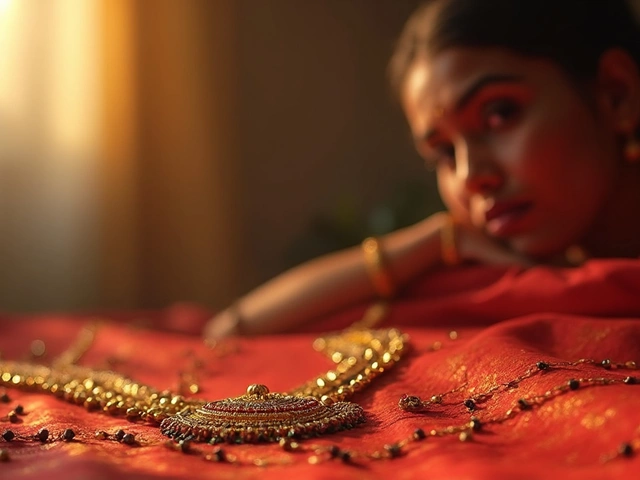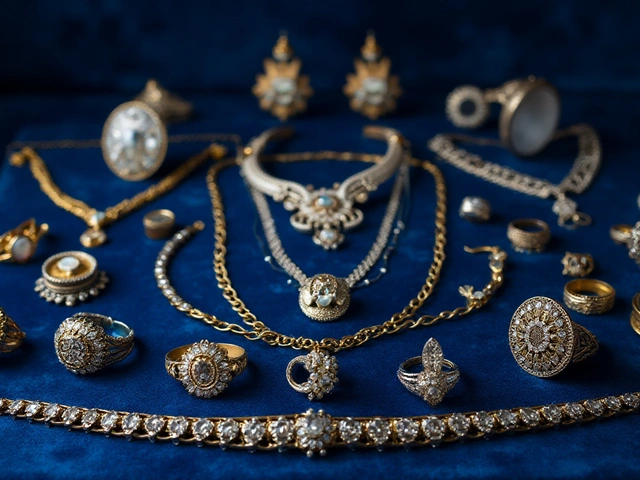
Ask anyone in India about “Moti”—the pearl— and you’ll dive straight into a mix of tradition, beauty, and some honestly wild superstition. You’d think a simple white orb couldn’t spark so much drama, but this is no ordinary gem. Whether it’s my aunt’s nagging about my “rahukalam,” or hearing someone rattle off a risky zodiac combination, pearls carry a reputation way beyond their looks. But who really shouldn’t be wearing moti? Let’s peel back the layers and get to the bottom of this glimmering question.
The Cultural and Astrological Roots of Moti
Moti isn’t just a gem. In India, Bangladesh, and across huge parts of Asia, it’s got a fierce reputation for calming the mind, stopping nightmares, and bringing peace. In Vedic astrology, moti represents the Moon—the planet responsible for your emotions, intuition, and, perhaps, that weird sad feeling you get at 2 AM. If your Moon is strong, a moti can make you feel even better, but if your Moon is weak or badly placed, it might stir things up. This is where all the rules start to come out.
A key belief: Only certain zodiac signs benefit from wearing moti. Astrologers claim that the real beneficiaries are Cancer (Karka), Pisces (Meen), and Scorpio (Vrishchik). For others, slapping a moti on your finger could backfire. The logic is that the stone’s energy amplifies whatever your Moon is doing. Got a crabby, irritable Moon? Wearing a moti could mean more mood swings, emotional shocks, or even petty arguments at home. People whose birth charts show the Moon as the “malefic”—especially for Leos (Simha), Aquarians (Kumbh), and Capricorns (Makar)—are told to avoid it outright unless an expert gives a crisp thumbs up.
This isn’t just tradition. Local gemstone sellers and priests take these warnings to heart. In Hyderabad’s Charminar, I once watched a guy refuse to sell a pearl to a woman because her chart, apparently, spelled ‘disaster’ with pearls. A bit dramatic? Maybe, but this kind of thinking runs deep.
Even outside astrology, moti is seen as a tool for focus. For kids, it’s said to reduce distractions and anxiety, but the flip side is that too much “peace” can make an already sluggish or uninspired person even lazier. My cousin wore a moti during exams and ended up sleeping through her afternoon maths test—true story. The bottom line: There’s no one-size-fits-all answer, and context matters more than you think.
Medical Concerns and Moti: Surprising Real-World Risks
You’d think a natural stone would be harmless, but wearing a moti brings health quirks too. Some people (especially those with allergies) react badly to pearls. The nacre—the juicy shine of the pearl—can trigger mild skin irritation, rashes, or even full-on dermatitis in rare cases. Sound far-fetched? There are still dermatology clinics in Mumbai seeing people who get red, itchy, or spotty after wearing cheap, chemically polished pearls. Not nice at all.
Another odd detail: Pearls are naturally porous. If you’re sweating a lot—say, during a Sydney summer or a North Indian heatwave—they absorb sweat and skin oils. Over time, this can lead to bacterial build-up on the jewelry. People with eczema or prone to skin infections could see their condition get worse. If you already have a nasty skin sensitivity, doctors suggest testing the pearl against your wrist or behind your ear for a day before wearing it fully. Sounds a bit odd? Not if you’d rather avoid a trip to the dermatologist—or worse, scratch your skin raw for a month.
But there’s more. If you’re on certain medications, you might be avoiding moti for another reason. People on hormonal medication, especially steroids or long-term corticosteroids, sometimes report that pearls feel ‘heavier’ or cause weird, tingling sensations. Some (no kidding) even believe pearls amplify medicine side effects like mood swings, though there are no strong clinical studies for this. My aunt, who suffered migraines, swears her pain got worse until she ditched her new pearl ring. Is it science or superstition? No solid answer, but personal stories keep cropping up.
| Group | Potential Risk with Moti |
|---|---|
| People with skin allergies | Risk of irritation, rash, dermatitis |
| Hormonal medication users | Possible increased sensitivity or discomfort |
| Active sportspersons | Absorption of sweat, higher bacteria risk |
Even if none of this sounds severe, being aware can save you a lot of itching, redness, or regret. If you’re still keen, go natural and choose pearls without heavy chemical coating—and steer clear of any “fashion pearls” that cost less than a lunch at the local cafe. Real moti isn’t supposed to make your hand stink or turn green. True pearls should feel cool to the touch, smooth, and comfortable for all-day wear, not itchy or sticky after an hour.

Psychological Effects: Can Moti Really Mess With Your Mood?
This part gets a bit philosophical. Moti is tied to the Moon, which—according to astrology—rules feelings, intuition, and imagination. Believers say it has the power to enhance sensitivity. That sounds nice, right? Well, if you’re a naturally anxious person, amping up those feelings could be a nightmare. Emotional types (hello, water signs) sometimes find their anxiety gets worse with a moti. There are stories floating around of people experiencing nightmares, weepy spells, or sudden mood swings after starting to wear pearls. My friend tried it for his ‘focus’—ended up having lucid dreams so weird he tossed the stone in a drawer and never looked back.
On the flip side, stoic or unfeeling types may actually benefit—if you struggle to connect with your emotions or find yourself a bit robotic, moti might soften things. But nobody likes having their mood played with. For some, the emotional boost is so strong it leaves them drained, weepy, or irritable. That’s not exactly the “calming” effect pearl fans brag about.
The psychological warning is clear: If you already have mental health challenges (like depression, high anxiety, or mood disorders), chat with an expert—maybe even your therapist—before rocking a pearl ring or necklace. There are a few small studies coming from Indian psychology departments, hinting at mild mood alteration in sensitive folk. They admit it could be placebo, but if anxiety is already your sidekick, be extra picky about the jewels you pick. Do you want peaceful dreams, or emotional turbulence?
If you’re a creative person—musicians, writers, artists—some say moti makes inspiration feel smoother and less blocked, but it also shuts down raw energy at times. That’s why you’ll never see most rockstars or adrenaline junkies obsessing about pearls. It’s all about balance, and sometimes moti’s calming vibe can turn your fire into a whimper if you aren’t wired for chill. Pick the gemstone that matches your personality rather than chasing generic “one size fits all” promises.
Group Warnings: Who Really Should Not Wear Moti?
This is where things get direct. If you’re in one of the following groups, think twice before wearing moti—or talk to an actual astrology pro, not just YouTube. Here’s a quick breakdown:
- Who should not wear moti: Leo (Simha), Aquarius (Kumbh), and Capricorn (Makar) signs, due to unfavorable Moon connections. Aries (Mesh) and Sagittarius (Dhanu) sometimes get a caution tag too.
- People with naturally low energy or those who already feel passive, sluggish, or foggy could get “worse” on moti, feeling lazier or less motivated.
- Patients with skin sensitivity or a history of allergic reactions to jewelry, especially natural gems.
- Folks with ongoing hormonal or psychological conditions—depression, high anxiety, bipolar disorder—should only wear pearls if cleared by a medical professional or therapist.
- Kids under 5, unless a pediatrician gives you the green light. Young skin is extra sensitive to the potential chemical treatments and bacteria on cheap pearls.
For anyone working with chemicals, cleaning agents, or industrial work—pearls are soft, scoring only 2.5–4.5 on the Mohs scale—consider skipping them or keeping their use limited. They’re way easier to scratch, crack, or ruin compared to tough stones like sapphire or diamond. If you cook a lot (especially spicy food) or do all the housework yourself, keep your moti ring off when handling strong soaps. No point in letting a beautiful gem turn into chalky dust after a few months.
Here’s another tip: Don’t rush out and buy a moti just because someone said it’s “cooling.” Get a proper assessment of your birth chart (if you’re a believer, that is). Go for natural pearls, ask the jeweler for test certificates, and for best effect, set your moti in silver—never gold, unless you get expert advice. Silver amplifies the Moon’s calming energy while avoiding possible gold/pearl clashes.

How to Check If Moti Is Right for You
Tried and true wisdom says to “test drive” your moti before making it a daily habit. If you have access to a trusted astrologer, have your birth chart checked for Moon placement and whether it’s getting hammered by any malefic planets (like Saturn or Rahu). If you’re a skeptic or just like wearing nice things, start by wearing moti for a few hours each day and watch how you feel: do you get sleepier, more emotional, clearer, or maybe just itchy? Take notes. Listen to your body, not just to stories.
If you’re buying a pearl ring, get one certified as “natural” (not cultured or synthetic) from a reputable seller. Look for a smooth surface, high luster, and a cool touch—these are easy giveaways. Don’t settle for fake pearls dipped in glossy paint; they’re uncomfortable and frankly, a bit tacky.
| Test | What to Look For |
|---|---|
| Half-day wear | Do you feel extra tired, emotional, or irritated? |
| Skin patch test | Any redness or spots after an hour? |
| Dream changes | Sudden nightmares or intense dreams? |
Ask your friends and family if they notice any shifts in your mood or energy. Sometimes you’re the last to see those subtle changes. If anything feels “off,” take a break. Pearls are supposed to support you, not drag you down. If wearing moti makes you feel like Luna (my cat) on a lazy Friday, it might not be the right fit for you.
Last thing: pearls are notoriously easy to scratch and damage. Keep them away from perfumes, harsh soaps, and don’t wear them while gardening, swimming, or brawling with your dog Sparky in the backyard. Store them in a soft pouch, and every few months, wipe them with a clean, damp cloth. A little care goes a long way.
The big lesson? Not everyone is built for pearls. Take your time, test, and notice how your mind, body, and daily rhythm interact with your new gem. Fancy traditions are great, but your own comfort and sense of “wellbeing” should always come first. And hey, sometimes, looking cool comes with a little homework. Worth it to avoid a jewelry mishap—or some wild dreams you didn’t bargain for.


